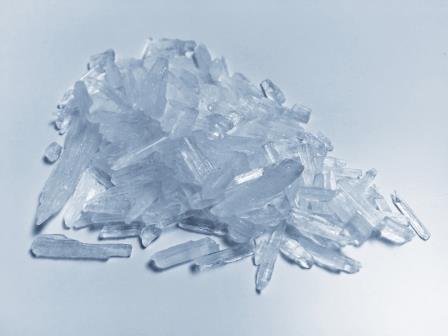Crystal meth is an extremely potent, highly addictive stimulant that targets the central nervous system. With its parent drug methamphetamine at its core, crystal meth is cooked in homemade laboratories and has therefore become one of the most accessible narcotics to adolescents today.
It has also become a drug of choice among young adults. Reaching the charts as one of the most commonly abused substances by youth in the United States, crystal meth assumes its form as a white, odorless crystalline powder. It is often sold in pill form, but is easily dissolved in water or alcohol. As a result, crystal meth can be inhaled, injected, or taking orally. According to the CEWG, however, most current users prefer to smoke the drug. Smoking or injecting crystal meth allows it to enter the bloodstream rapidly. The drug is then swiftly carried to the brain, producing an immediate “rush” or “flash.”

Methamphetamine, a direct relative of amphetamine, remains on the shelves and is used today to treat conditions such as narcolepsy, obesity and ADHD. The prescription drug, however, poses a great risk for addiction. Unlike amphetamine, the average dose of methamphetamine is extremely potent: it carries much greater amounts of the drug directly to the brain, rather than having an even distribution throughout the body. As a result, a meth user will experience more intense side effects. These effects are longer lasting, but can be particularly harmful to the central nervous system with long-term use.
Derived from methamphetamine, crystal meth is a chemically altered version of the prescription drug. During its production, the methamphetamine is crystallized and later smoked through a glass pipe, thus giving crystal meth its street names “ice” and “crystal.” Its production, however, is not so clear and clean. The synthetic drug is composed of a wide array of other substances and poisons, including, but not limited to: cold and allergy medicines, other prescription drugs, household cleaning products, even battery acid and antifreeze. Adolescents buying the drug have no idea what their batch will contain. Crystal meth is a blend of lethal components that lead it to be one of the most dangerous drugs on the street today.
Signs & Symptoms of Crystal Meth Addiction:
Crystal meth abuse poses the risk for severe damage to the brain, nervous system, heart, and respiratory system in long-term users. Because each batch is concocted with different toxic additives, crystal meth symptoms and side effects can vary and extend far beyond the common side effects of methamphetamine.
Immediate symptoms of crystal meth abuse include:
- Increased wakefulness and insomnia
- Talkativeness
- Decreased appetite, often leading to anorexia
- Increased heart rate, breathing, and blood pressure
- Hallucinations
- Sensations of flesh crawling (causing users to pick at skin and create open wounds)
Long-term symptoms of crystal meth addiction:
- Anxiety or paranoia
- Hypothermia and convulsions
- Cardiovascular issues
- Stroke
- Brain damage
- Damage to blood vessels
- Kidney failure
- Internal bleeding
- Blindness
- Muscle breakdown, brittle bones
- Weight loss
- Severe dental problems (“meth mouth”)
- Reduced motor speed and impaired verbal learning
Crystal Meth Addiction Treatment:
As a long-term treatment facility that supports young men through drug addiction, Turning Point has found that the best way to approach crystal meth dependency in young adults is through a combination of drug testing, detoxification, behavioral therapies, education, individual counseling, 12-Step support, and the adoption of new, healthy hobbies to replace old drug-using activity. Methamphetamine and crystal meth are powerful stimulants that bear severe withdrawal symptoms. Treatment, therefore, needs to address all aspects of the addiction in order to prevent relapse. This can be best done through an inpatient treatment center, so that those battling crystal meth addiction can recover in a stable environment, free from outside triggers and temptations.